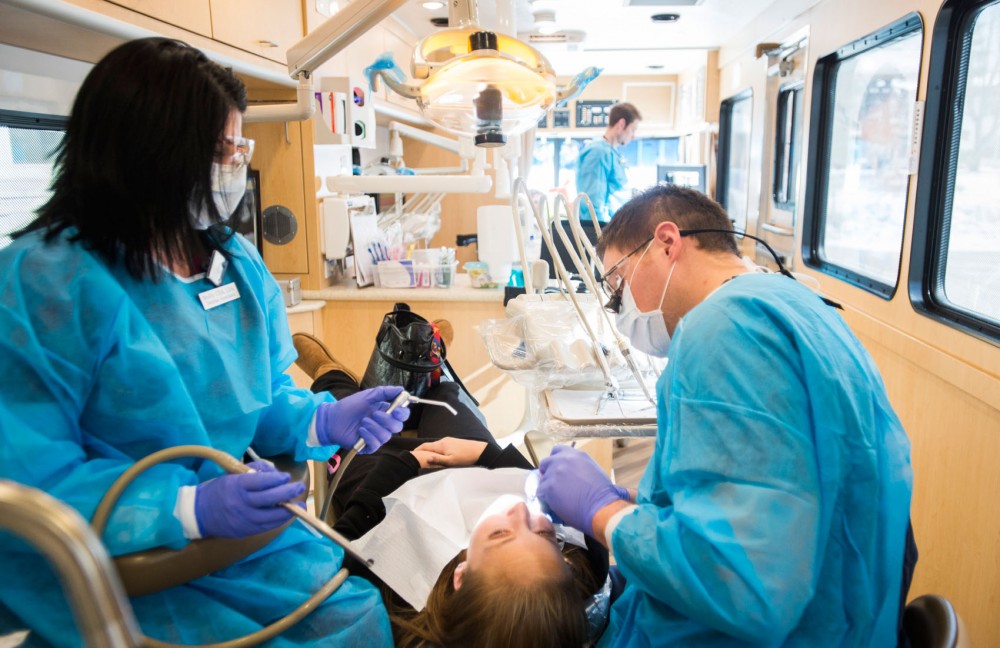A woman went to the UCare Mobile Dental Clinic with a chipped front tooth and walked out with a fresh smile and tears of joy in her eyes Wednesday morning.
“That’s fun when you have outcomes like that, with people who really appreciate the work that gets done for them,” said Bill Johnson, the fourth-year University of Minnesota dentistry student who helped her.
The mobile dental clinic started more than 10 years ago for patients in urban and rural areas who have limited access to dental health care, said Paul Schulz, director of the outreach program at the University School of Dentistry.
Schulz said the mobile clinic is a collaborative effort between the UCare Health Care Program and the dentistry school. UCare members can get checkups, cleanings and simple restorative care.
Rural parts of Minnesota are short on dentists compared to urban areas, Schulz said.
“There’s not necessarily a shortage of dentists in this state,” he said. “But they’re just not equally distributed.”
In 2010, just 26 percent of the 3,908 dentists who renewed their Minnesota license were practicing in rural areas, according to the Minnesota Department of Health.
More than 1,400 faculty-supervised dental, dental hygiene and dental therapy students have worked in the clinic. Schulz said it travels more than 15,000 miles to both metro-area and rural locations in Minnesota.
The mobile dental clinic is one of 12 outreach sites throughout the state where dental access is limited, Schulz said.
“As a land-grant institution, the University of Minnesota has an obligation to give back to the state of Minnesota,” Schulz said. “And this is one way we feel that we can directly impact the state and their oral health by providing these outreach clinics.”
Students work in the clinic for a week at a time, but Schulz said it also has full-time staff that travels throughout the year, spending 13 weeks outside of the Twin Cities metro area.
Susan Raden said she’s worked in the mobile clinic as a dental assistant since it began in 2002.
“It’s very gratifying,” Raden said. “There’s a lot of great people and fun places to go to besides the metro area.”
Dentistry students don’t usually have the opportunity to work with dental assistants, so outreach clinics give them the opportunity to learn more about “four-handed dentistry,” said Eric Thiede, a fourth-year dentistry student.
“The patients are some of the nicest and most genuinely appreciative as a group,” Thiede said.
As a graduation requirement, Schulz said dental students need to spend at least two months in an outreach clinic.
By exposing students to this type of work, Schulz said they’ll consider living and practicing in rural Minnesota.
Several clinics in northern Minnesota were underserved before the program started, Schulz said, but three of the four have since been filled by dentistry school graduates.
“So, we’re seeing that it does make an impact to bring students to an area where there is a shortage,” Schulz said.
Besides working in the dentistry clinic, Johnson said he also spent a month at the outreach clinic in Willmar County.
“The best part of the dentistry school, I think, is outreach,” Johnson said.
Other Efforts
The Mobile Dental Clinic is part of the dentistry school’s efforts to reach underserved areas.
The Early Decision Rural Dentistry Track Program started in 2009, recruiting undergraduate students from rural areas who are interested in pursuing rural dentistry, said Naty Lopez, assistant dean for admissions and diversity.
The rural-track program has been funded by two grants totaling nearly $200,000 from the Minnesota Department of Health and the Health Resources and Services Administration, Lopez said.
The program gives students scholarships, Lopez said, and in return they are expected to shadow a rural dentist and complete a community project that addresses dental health disparities in those communities.
The dentistry school is also considering a rural dentistry track program for current dentistry students, but Lopez said the curriculum is still in development.
“There’s a lot more work that needs to be done before we can have this rural education track,” Lopez said. “But we are surely moving along.”








